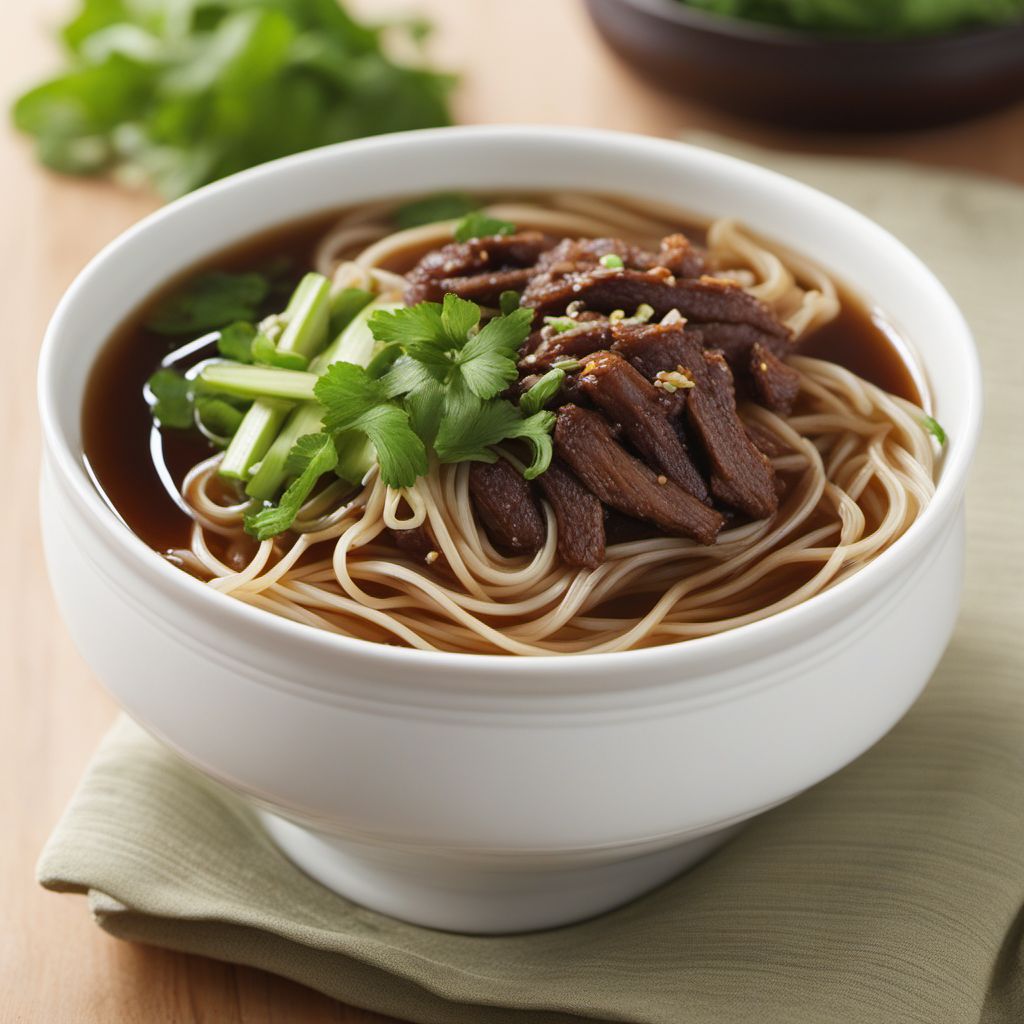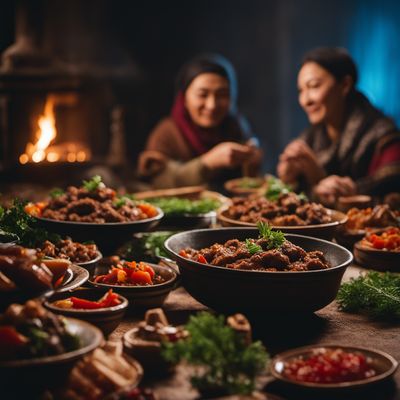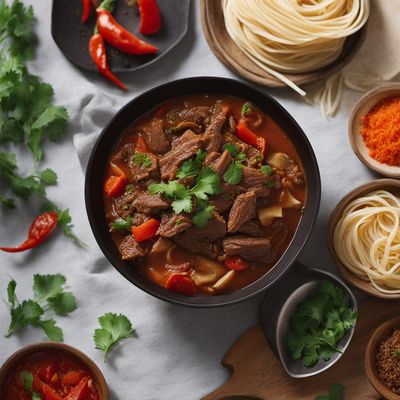
Recipe
Chinese Islamic Beef Noodle Soup
Silk Road Delight: Chinese Islamic Beef Noodle Soup
4.5 out of 5
Indulge in the flavors of Chinese Islamic cuisine with this hearty and comforting Beef Noodle Soup. Inspired by the Silk Road, this dish combines tender beef, aromatic spices, and hand-pulled noodles to create a satisfying and nourishing meal.
Metadata
Preparation time
20 minutes
Cooking time
1 hour 30 minutes
Total time
1 hour 50 minutes
Yields
4 servings
Preparation difficulty
Medium
Suitable for
Halal, Gluten-free (if using gluten-free soy sauce and hoisin sauce), Dairy-free, Nut-free, Low-fat
Allergens
Soy (in soy sauce and hoisin sauce), Oyster sauce (contains shellfish)
Not suitable for
Vegetarian, Vegan, Paleo, Keto, High-protein
Ingredients
In this adaptation of Sulu khingal to Chinese Islamic cuisine, we replace the lamb with beef and incorporate Chinese Islamic flavors. The original dish is a Kyrgyz noodle dish made with lamb, onions, and spices, while the Chinese Islamic version features beef, aromatic spices like star anise and Sichuan peppercorns, and hand-pulled noodles. The Chinese Islamic Beef Noodle Soup is influenced by the Silk Road trade route, which brought diverse culinary traditions to China, resulting in a unique fusion of flavors. We alse have the original recipe for Sulu khingal, so you can check it out.
-
500g (1.1 lb) beef shank, thinly sliced 500g (1.1 lb) beef shank, thinly sliced
-
1 onion, thinly sliced 1 onion, thinly sliced
-
4 cloves garlic, minced 4 cloves garlic, minced
-
1-inch ginger, grated 1-inch ginger, grated
-
2 star anise 2 star anise
-
1 cinnamon stick 1 cinnamon stick
-
1 teaspoon Sichuan peppercorns 1 teaspoon Sichuan peppercorns
-
4 cups (950ml) beef broth 4 cups (950ml) beef broth
-
2 cups (470ml) water 2 cups (470ml) water
-
2 tablespoons soy sauce 2 tablespoons soy sauce
-
1 tablespoon dark soy sauce 1 tablespoon dark soy sauce
-
1 tablespoon oyster sauce 1 tablespoon oyster sauce
-
1 tablespoon hoisin sauce 1 tablespoon hoisin sauce
-
1 tablespoon vegetable oil 1 tablespoon vegetable oil
-
200g (7 oz) hand-pulled noodles 200g (7 oz) hand-pulled noodles
-
2 cups bok choy, chopped 2 cups bok choy, chopped
-
1 cup bean sprouts 1 cup bean sprouts
-
Salt and pepper to taste Salt and pepper to taste
-
Fresh cilantro, chopped (for garnish) Fresh cilantro, chopped (for garnish)
-
Green onions, sliced (for garnish) Green onions, sliced (for garnish)
Nutrition
- Calories (kcal / KJ): 380 kcal / 1590 KJ
- Fat (total, saturated): 12g, 3g
- Carbohydrates (total, sugars): 40g, 6g
- Protein: 28g
- Fiber: 5g
- Salt: 2.5g
Preparation
-
1.In a large pot, heat the vegetable oil over medium heat. Add the sliced onions, minced garlic, and grated ginger. Sauté until fragrant and the onions are translucent.
-
2.Add the beef slices to the pot and cook until browned.
-
3.Add the star anise, cinnamon stick, and Sichuan peppercorns to the pot. Stir for a minute to release their flavors.
-
4.Pour in the beef broth and water. Bring to a boil, then reduce the heat and let it simmer for 1 hour, skimming off any impurities that rise to the surface.
-
5.Stir in the soy sauce, dark soy sauce, oyster sauce, and hoisin sauce. Simmer for an additional 30 minutes to allow the flavors to meld.
-
6.Meanwhile, cook the hand-pulled noodles according to the package instructions. Drain and set aside.
-
7.Add the bok choy and bean sprouts to the soup. Cook for 2-3 minutes until the vegetables are tender-crisp.
-
8.Season the soup with salt and pepper to taste.
-
9.To serve, divide the cooked noodles among bowls and ladle the hot soup over them. Garnish with fresh cilantro and sliced green onions.
Treat your ingredients with care...
- Beef shank — For tender beef slices, it's best to thinly slice the beef against the grain. This will ensure the meat remains tender after cooking.
- Hand-pulled noodles — If you can't find hand-pulled noodles, you can substitute with fresh or dried wheat noodles. Cook them according to the package instructions before adding them to the soup.
Tips & Tricks
- To enhance the flavor of the broth, you can add a small piece of rock sugar while simmering.
- For a spicier kick, add a teaspoon of chili oil or chili flakes to the soup.
- If you prefer a thicker broth, you can dissolve a tablespoon of cornstarch in water and add it to the soup during the last few minutes of cooking.
Serving advice
Serve the Chinese Islamic Beef Noodle Soup hot, garnished with fresh cilantro and sliced green onions. Accompany it with a side of chili oil or chili sauce for those who prefer a spicier taste. Enjoy it with a pair of chopsticks and a Chinese soup spoon for an authentic experience.
Presentation advice
When serving the Chinese Islamic Beef Noodle Soup, make sure to arrange the beef slices, vegetables, and noodles beautifully in the bowl. The vibrant colors of the ingredients will make the dish visually appealing. Serve it in traditional Chinese bowls to enhance the presentation.
More recipes...
More Kyrgyz cuisine dishes » Browse all

Chukuchuk
Chukuchuk is a traditional Uzbek dish made with lamb and vegetables. It is a hearty and flavorful dish that is perfect for cold winter nights.

Mypalau
Mypalau is a traditional dish from Palau, a small island nation in the western Pacific Ocean. It is a hearty stew made with a variety of meats and...

Hafalaab
Hafalaab is a traditional Yemeni dish that is perfect for a light meal. It is a type of pancake that is made with flour, water, and spices. The...







